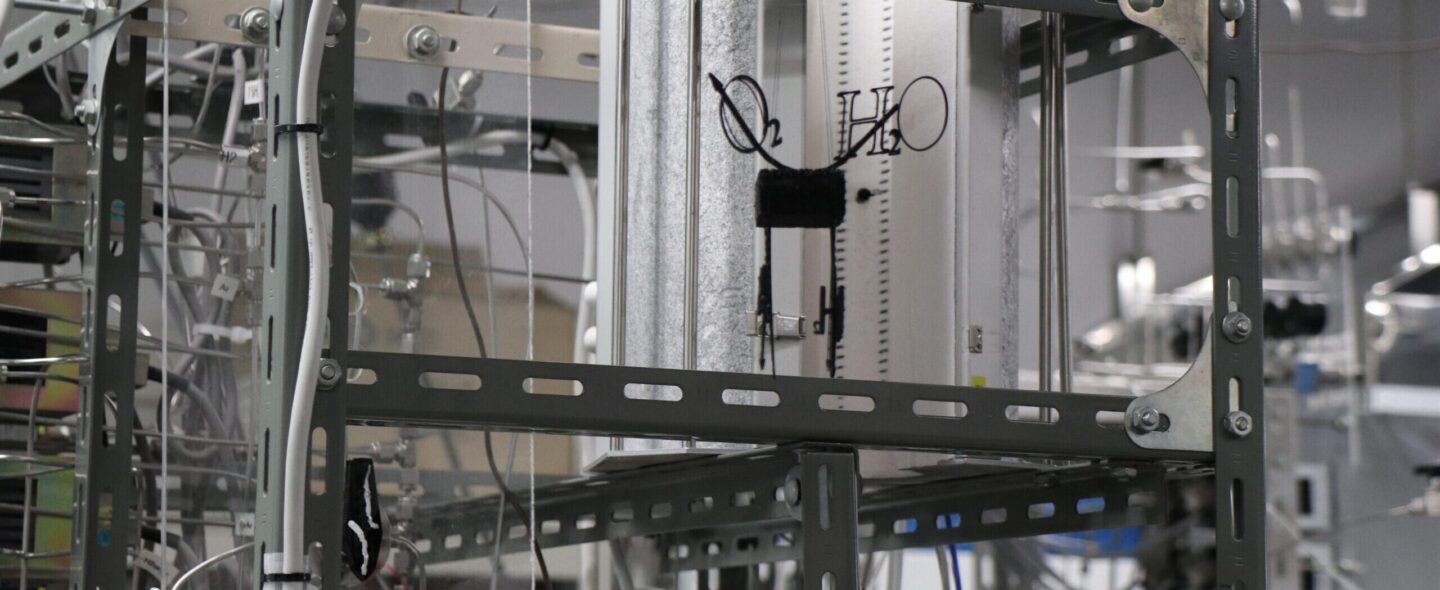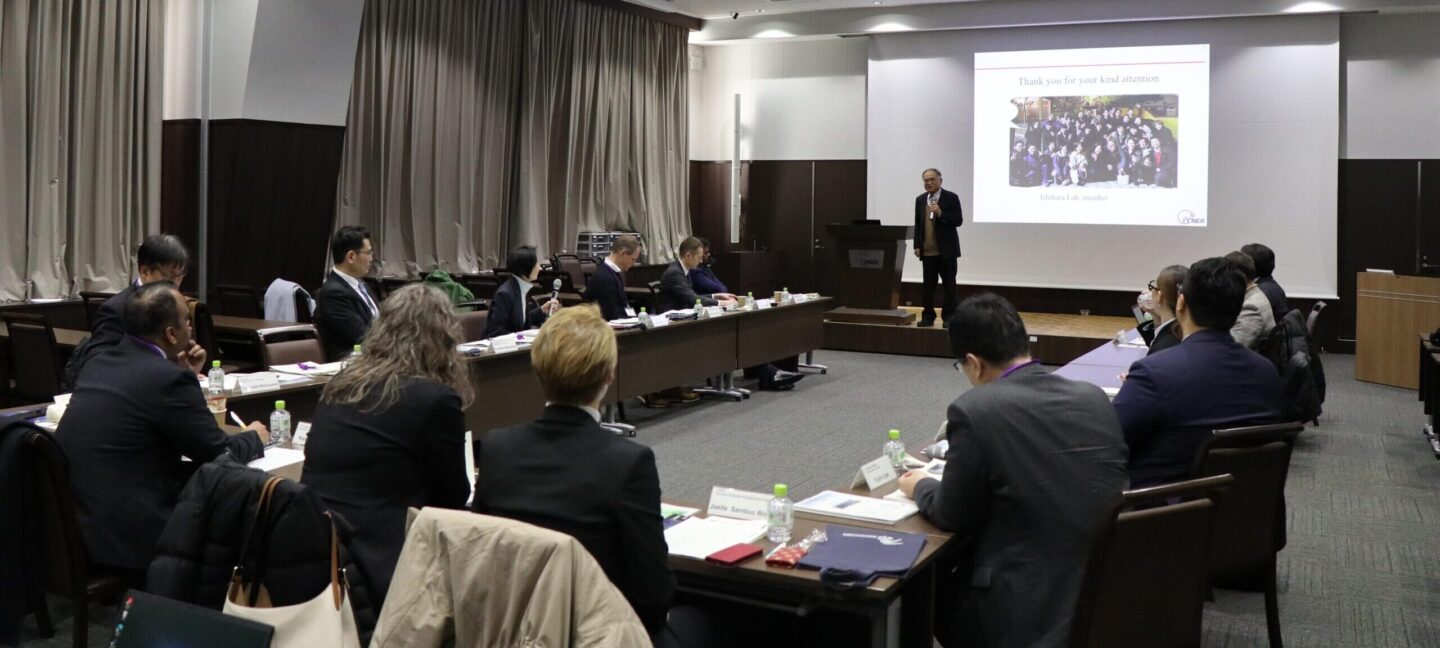

On February 14, 2025, members of the Science & Technology Diplomatic Circle (S&TDC) from Australia, Denmark, Germany, India, Lithuania, the Kingdome of Netherlands, New-Zealand, and Switzerland gathered in Fukuoka to learn the latest developments at I²CNER. Jointly organized by I²CNER, the Japan Society for the Promotion of Science (JSPS) and the Science & Technology Office (STO) Tokyo as co-member of the secretariat of the S&TDC, the visit enabled active exchanges between the participants and the researchers and discussions on follow-ups.
The visit began with an introduction to I²CNER by its Director, Prof. Tatsumi Ishihara, providing an overview of the center’s mission to advance low-carbon and cost-effective energy systems. He presented the three overarching research units: Advanced Energy Materials, Advanced Energy Conversion Systems, and Multiscale Science and Engineering for Energy and the Environment. Their research aligns with Japan’s 3E+S policy, focusing on Energy Security, Economic Efficiency, Environment, and Safety, and covers key areas, including hydrogen energy, carbon capture and utilization, advanced energy materials, and energy conversion systems. The institute’s research has progressed technologies from basic science to market deployment, publishing numerous highly cited academic papers and filing multiple patents in the process.
He emphasized I²CNER’s active participation in global research initiatives by mentioning their strong commitment to international knowledge exchange through collaborative efforts with institutions in 20 foreign countries. The institute’s brain circulation model ensures a steady flow of researchers contributing to and benefiting from I²CNER’s advancements. Looking ahead, he explained that by 2025, I²CNER aims to significantly contribute to Japan’s goal of achieving a “virtually zero” carbon society. Their strategies include maximizing renewable energy introduction, promoting hydrogen and ammonia as alternative energy sources, utilizing carbon removal technologies, and enhancing energy efficiency across various sectors.
The program continued with presentations by leading professors of I²CNER and explored cutting-edge research in areas such as hydrogen energy, carbon capture and advanced materials. Then the S&TDC members had the opportunity to visit some laboratories and get a first-hand look at the institute’s research and technologies.
Research Presentations
Prof. Tatsumi Ishihara
The Ishihara lab develops efficient solid oxide fuel cells (SOFCs), which operate effectively at lower temperatures, making them more practical for diverse applications. His team also investigates dual-carbon lithium-air batteries, known for their high energy density and potential for safer energy storage. Moreover, their research includes inorganic-organic catalysts for energy conversion, aiming to enhance efficiency and sustainability in energy systems.
Prof. Toshinori Matsushima
His team advances solar power conversion through perovskite solar cells. Perovskite materials, named after the mineral CaTiO3, are cost-effective, flexible, and highly efficient, making them ideal for various electronic applications. Their research has led to significant improvements in the efficiency and durability of perovskite solar cells, increasing their efficiency from 21.68% to 24.22%. To emphasize the significance of their research, he highlighted that the development of diverse solar cell architectures, including film-type, glass-type, and tandem-type cells, is rapidly progressing in Japan. Companies like Sekisui Chemical, Panasonic, and Kaneka are leading efforts to commercialize these technologies.
Prof. Aleksandar Staykov
He leads a research group focusing on energy-related materials and surface reactions. His team is characterized by its international composition and expertise in theoretical chemistry and computational materials science. They use advanced computational techniques and machine learning algorithms to design new materials for energy applications. Their research includes advancements in SOFCs and solid oxide electrolysis cells (SOECs), improving gas separation membranes using polydimethylsiloxanes (PDMS), and exploring chemical mitigation of hydrogen embrittlement to enhance material durability.
Laboratory Tours
Prof. Shigenori Fujikawa
His team's work primarily revolves around developing advanced materials and methods for carbon capture and utilization. One of his key research areas is the creation of high-performance nanomembranes for gas separation, crucial for capturing carbon dioxide (CO2) directly from the atmosphere. His team also explores the design and application of nanostructured materials, including self-standing nanomembranes and three-dimensional nanostructures. These materials have significant potential in various fields, such as energy storage, environmental protection, and sustainable development.
Prof. Hiroshige Matsumoto
The Matsumoto Laboratory focuses on advancing electrochemical energy conversion technologies. Their work involves the study of ion-conducting ceramics and their applications in SOFCs and SOECs, crucial for efficient energy conversion and storage. Prof. Matsumoto's research team also explores water and steam electrolysis, essential processes for producing hydrogen, a clean and renewable energy source. His lab aims to enhance the efficiency and scalability of these technologies.
Prof. Masanobu Kubota
He presented pioneering research on developing steels and alloys to withstand hydrogen environments. Collaborating with institutions like the University of Illinois and the University of Göttingen, his team focuses on materials essential for hydrogen production, storage, and transportation. Key research areas include developing molecular and nanomaterials, addressing hydrogen embrittlement, and studying high-temperature hydrogen utilization. Their research has significant implications for industries such as transportation, energy, and manufacturing.
The visit to I²CNER showcased the institute’s holistic approach to addressing energy challenges through innovative research and international collaboration. Their advancements in energy materials, conversion systems, and sustainability strategies position them as a key player in the global effort to achieve a carbon-neutral future. The dedication and expertise of the researchers at I²CNER, which we were able to witness during the visit, perfectly illustrate the importance of interdisciplinary and collaborative efforts in driving meaningful progress towards a sustainable energy future.


